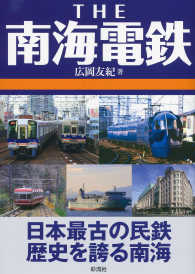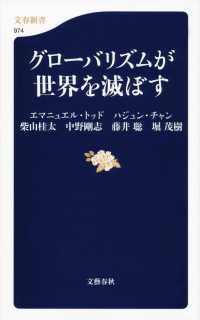- ホーム
- > 洋書
- > 英文書
- > History / World
Full Description
A history of military-technological innovation in Russia.
This book traces the dynamics of military-technological innovation in Russia over the last hundred and fifty years, particularly focusing on three distinct periods: the introduction of rifled breech-loading weapons in Imperial Russia in the nineteenth century, the invention of nuclear weapons in the Soviet Union in the twentieth century, and the development of precision-guided weapons in post-Soviet Russia in the twenty-first century. The analysis relies extensively on primary data obtained from Russian archives, complemented by a series of expert interviews, and deciphers Russia' s distinct strategic cultural approach to military-technological innovation.
Contents
List of Abbreviations 3
List of Figures 4
Introduction 5
. Military Technology in Russian Strategic Thinking 2
. Technology as an Added Value to the Nation's Military Power 3
.2 Technology as a Component of Defence Capability 5
.3 Technology as a Political Artefact 7
.4 Technology as a Highly Constrained Domain 8
.5 Technology as a Source of Asymmetry 9
. Technology as a Subject of Diplomacy 2
2. Russia's Strategic Cultural Approach to Military-Technological Innovation: An Analytical Framework 24
2. Recurring Patterns and Strategic Culture 25
2.2 Triangular Conceptualization of Russia's Strategic Cultural Approach to Military-Technological Innovation 32
2.3 Russia's Organizational Culture: Developmental State Models 43
2.4 Putting the Process in Motion: Conflict Dynamics 45
2.5 Research Methodology 47
3. Rifled Breech-Loading Weapons 52
3. The Crimean War as a Major Turning Point 52
3.2 The Quest for Symmetry and Emulative Tendencies 55
3.3 Beyond Technology: Preserving Russia's Asymmetric Advantage 9
3.4 Russia's Diplomatic Response: The Hague Conference of 899 72
3.5 Synthesis of the Approach: A Range of Asymmetric Reactions 82
4. Nuclear Weapons and Delivery Vehicles 87
4. Asymmetric Response to the World's First Atomic Bombings 88
4.2 Forced into the Revolution in Military Affairs 9
4.3 The Circle Closes: The Role of the USSR in Nuclear Arms Control
4.4 Synthesis of the Approach: Two Seemingly Incompatible Paths 22
5. Precision-Guided Conventional Weapons 28
5. Conceptualization of Revolutionary Potential 29
5.2 Going (A)symmetric: Failed Ambitions of the USSR 35
5.3 The Gulf War as a Major Turning Point 4
5.4 Asymmetric Assurance: The Nuclear Escalation Ladder 43
5.5 Seeking Symmetry: Embarking on the Revolution in Military Affairs 48
5. Twisted (A)symmetries 7
5.7 Synthesis of the Approach: Ambitions for Symmetry and Asymmetric Engagement 75
. Conclusion 8
. Synthesis and Outline of the Russian Strategic Cultural Approach to Military-Technological Innovation 83
. . Reactive Innovation 84
. .2 Punctuated Innovation 87
. .3 Compensatory Innovation 9
. .4 Reluctant Innovation 92
. .5 Steered Innovation 95
. . Symbolic Innovation 97
. .7 Manpower-Balanced Innovation 2
.2 Asymmetric Balancing and Further Contributions 2 3
List of References 2 8
List of Interviews 242







